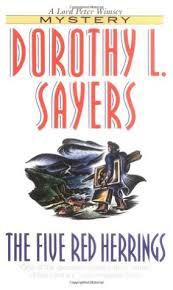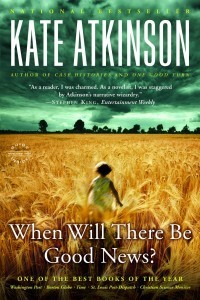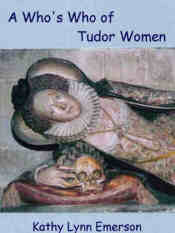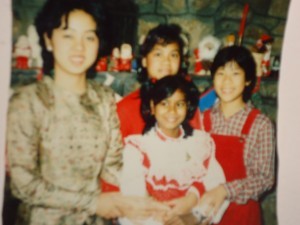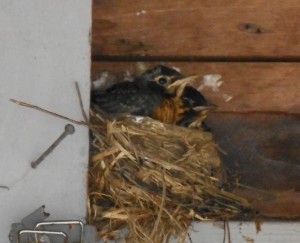Kathy Lynn Emerson's Blog, page 79
March 25, 2016
Weekend Update: March 26-27, 2016
 Next week at Maine Crime Writers there will be posts by John Clark (Monday), Jessie Crockett (Tuesday), special guest Peter Murray (Wednesday), a special group post (Thursday), and Maureen Milliken (Friday).
Next week at Maine Crime Writers there will be posts by John Clark (Monday), Jessie Crockett (Tuesday), special guest Peter Murray (Wednesday), a special group post (Thursday), and Maureen Milliken (Friday).
In the news department, here’s what’s happening with some of us who blog regularly at Maine Crime Writers:
from Kaitlyn Dunnett/Kathy Lynn Emerson: A busy stretch coming up. On the evening of April 4, I’ll be on a Sisters in Crime panel at Storrs Library in Longmeadow, MA with fellow mystery writers Susannah Hardy/Sadie Hartwell and Sharon Healy-Yang. For more information click here: longmeadowlibrary.org
Then there’s Maine Crime Wave coming up on April 8-9. You’ve seen these links before, but here they are again.
+ MAINE CRIME WAVE http://mainewriters.org/2016-maine-crime-wave/
+ SCHEDULE http://mainewriters.dreamhosters.com/?page_id=3223
+ PANELISTS & WORKSHOP LEADERS http://mainewriters.org/panelists-workshop-leaders/ + REGISTRATION DUE April 5, 2016
+ TWO MINUTES IN THE SLAMMER Open Mic Reading Friday, April 8
And, finally, at 1PM on April 14, Maureen Milliken, Janet Morgan and I will be fellow panelists at Lithgow Library in August, ME. I’ll post more details about that appearance closer to the date.
An invitation to readers of this blog: Do you have news relating to Maine, Crime, or Writing? We’d love to hear from you. Just comment below to share.
And a reminder: If your library, school, or organization is looking for a speaker, we are often available to talk about the writing process, research, where we get our ideas, and other mysteries of the business. Contact Kate Flora: mailto: kateflora@gmail.com
March 24, 2016
I’m Just A Girl Who Can’t Say No
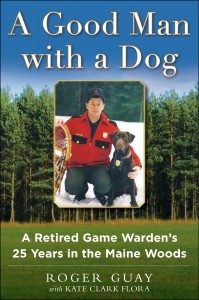 Kate Flora: Lest you get the impression that I am on vacation in Florida this month, I thought I’d share some of my poolside reading. There’s In Defense of Self and Others: Issues, Facts & Fallacies – The Realities of Law Enforcement’s Use of Deadly Force. There’s Into the Kill Zone: A Cop’s Eye View of Deadly Force. I’ve read the report of the president’s task force on 21st century policing, and the report of the International Association of Chiefs of Police on police-community relations. I have a stack of folders several inches high with interviews with police officers, and I have dozens of articles on the use of deadly force and on police officer training. For recreation, I’ve been sneaking away from all that to read the grand jury transcripts in the Darren Wilson/Michael Brown case.
Kate Flora: Lest you get the impression that I am on vacation in Florida this month, I thought I’d share some of my poolside reading. There’s In Defense of Self and Others: Issues, Facts & Fallacies – The Realities of Law Enforcement’s Use of Deadly Force. There’s Into the Kill Zone: A Cop’s Eye View of Deadly Force. I’ve read the report of the president’s task force on 21st century policing, and the report of the International Association of Chiefs of Police on police-community relations. I have a stack of folders several inches high with interviews with police officers, and I have dozens of articles on the use of deadly force and on police officer training. For recreation, I’ve been sneaking away from all that to read the grand jury transcripts in the Darren Wilson/Michael Brown case.
You may well ask: Why?
And as a storyteller, I’ll launch into the tale. It all began many years ago when my New York publisher decided to drop my Thea Kozak series. As I flailed and floundered about, trying to figure out what to do next, I realized that learning to write about crime had necessarily meant I had to learn about the police. So in an impulsive moment, I decided to start a new series—a police procedural series—and set it in Portland, Maine. At the time, the decision seemed reasonable. I liked writing series characters and I was interested in the police. Little did I know how convoluted the path would get.
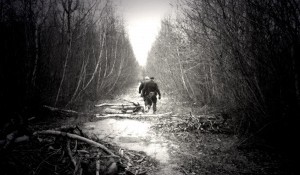
Wardens walking down the tote road to search for Amy.
Some e-mails and phone calls got me a contact in the Portland police department. Cool, I thought, I’ve got an informant who can answer my police-related questions. Little did I imagine that I would end up answering his writing-related questions. Even less did I imagine that while he was informing me about how the police worked, he would be involved in investigating a tragic homicide and want to write a book about it. Pretty soon my little bit of help became quite a lot of help, which morphed into a collaboration with Acting Chief Joe Loughlin and the powerful true crime book that became Finding Amy.
Then the road took another twist. Even as I was vowing never to touch nonfiction again, Maine Warden Service Lt. Pat Dorian, who organized the search that found Amy’s body, (and who, by the way, walks on water), told me about another case I might find interesting. Breaking my vow to never touch true crime again, I asked him some questions, found the answers fascinating, and soon was on the road to Miramichi, New Brunswick. Five years, two trials, and several appeals later, David Tanasichuk’s conviction for the murder of his wife Maria was finally final—and I had another true crime book under my belt, Death Dealer: How Cops and Cadaver Dogs Brought a Killer to Justice. (I also got to go the range when they requalified, go on a stake out where I spotted the bad guy, and drive a four-wheeler into the Canadian woods to see the gravesite.) I also developed a deep, and lasting, affection for the officers involved in the investigation.
But I had had enough of the real world. Fiction was calling. I was on deadline to write another Thea Kozak mystery. I wanted to spend more time with my fictional detective, Joe Burgess, and his team. And then, of course, the phone rang. Roger Guay, a recently retired Maine game warden said he liked the way I’d written Finding Amy. He’d always heard that he told good stories and should write them down, but he didn’t know how. Could I help?
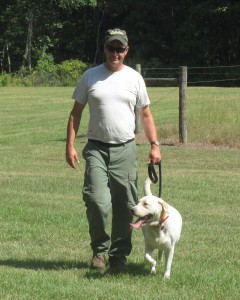
Roger Guay and Saba
Another three years have passed. I’ve had the adventure of doing my interviews in a pickup truck while traveling the back roads around Greenville, Maine. I’ve gotten to follow Maine wardens through tick-filled woods and fields while I watched them train their K9s. I’ve been lost—and found. I’ve struggled to figure out how to translate what I know about writing fiction and true crime into helping Roger write his memoir. I’ve watched the story go from cute animal tales and wily ways of catching fish and game poachers to the tragedy of those who have died in the woods. I’ve watched a man’s resilience and optimism get battered by tragedy and the chaos and FEMA screw-ups in New Orleans after Katrina. I’ve learned about the incredible bond between a handler and his K9. I’ve learned something about how to write memoir.
You can listen to us here: “Missing Persons/Homicide Investigations and Body Recovery/Cadaver Dogs”
http://itsacrime.podomatic.com/entry/2012-04-14T21_02_51-07_00
What I obviously haven’t yet learned is how to say no. So now, as Roger’s wonderful stories and deeply personal narrative are about to appear in A Good Man with a Dog, I’m back at my desk, trying to help Joe Loughlin again. This time, the project is bringing the public inside the realities of officer-involved shootings, the work-in-progress tentatively titled: Shoot, Shoot, Shoot! The Myths, Misconceptions, and Misunderstandings about Officer-involved Shootings.
Of course I’m already saying: Never again. Don’t call me up and say you’ve got a story to tell and ask if I can help.
And of course, there’s already another cop out there with a story to tell who may need my help. And I just know, that now that Roger Guay is a P.I., that there has to be a sequel to Good Man called Backwoods Private Eye.
I know that not saying “no” brings me amazing friends and powerful insights. It lets me use what I know to help people tell important stories. I also know that probably, the next time the call comes, I’ll be saying yes again.
March 23, 2016
How to read a mystery novel
By Maureen Milliken
One of the surprising things I’ve found since my first mystery novel was published last year is that there are people who don’t read mysteries.
I guess it shouldn’t surprise me. There are genres I don’t read. But I was surprised anyway.
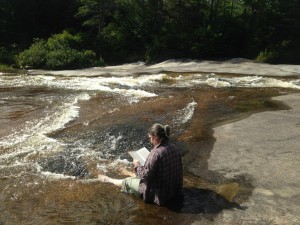
I remember exactly what I was reading here, Kate Atkinson’s “Emotionally Weird.” When you can’t put a book down, you can’t put it down.
I’ve been reading mystery novels as long as I’ve been reading books, so it never occurred to me that some of the things about mysteries that those of us who read and write them take for granted come as surprises to those who don’t.
As I finish up the second book in the Bernie O’Dea mystery series, No News is Bad News, some of the comments from non-mystery readers who have read the first, Cold Hard News, remind me of the elements that we take for granted in mysteries. I’d like to add, that all of these non-mystery readers were gracious. They all said they enjoyed the book, so I’m hoping they are converts.
For those yet to see the light, though, I’ve put together this tip sheet.
CHARACTERS
I know. Every book has them. But their special role in a mystery novel is all-important. There will be at least one character, maybe more, who you care about enough that when they face danger (yes, they will, it’s a given), you get nervous and shaky. I love characters and they’re the most important thing to me in any book I read or write. Characters are plot. Why people do what they do is behind every good mystery.
INFERENCE GAPS
Ugh. I know! Back to college English class. I wish the term was catchier, but what this means is that there’s information that won’t be given to you right away. Things will be hinted at or referred to and you’ll wonder what it means. Don’t get frustrated and think the writer is leaving things out. Later, things may happen, both little and big, that will help fill in the gap. Oh! That’s why he said he’d never go to Rumford again! If the writer lays every detail out for you from the beginning, there’s really no reason to keep reading. You want to be curious enough about things that you’ll turn that page. The only exception to this is in a series, when things that happened in previous books are referred to. That may throw you off if you’re not starting with the first book, but hopefully it will intrigue you, too. No News is Bad News starts a few months after Cold Hard News ended. It’d be nuts for some of the people in the book not to be affected by what happened. They keep saying they’ve moved on, but they haven’t and it shows. Readers of mystery series are used to this, but you may not be. Solution? Go back and read the previous books!
I’ve always loved this term. At least three people who read Cold Hard News remarked that they liked the fact there were clues that made them think someone else was the bad guy, or they were led for a while to believe a different motive. Red herrings! False clues. People who you think are the murderer, but turn out not to be. If you really want a full plate of red herring, I recommend Dorothy L. Sayers’ The Five Red Herrings. It’s got a train schedule time-table plot that I never could untangle, but the red herrings are delicious.
QUESTIONS THAT NEED ANSWERING
Why is he acting like that? What did she take from the cupboard when Rupert left the room? Who killed that guy, anyway? Why? Things will happen and they won’t immediately be explained. This is different from the inference gap. These are BIG questions. I’m not a plot person. When I read a mystery, I let the plot wash over me. If I figure it out before the end of the book, the writer didn’t work hard enough. I’ve probably read Sayers’ Murder Must Advertise seven or eight times, and I’m still not exactly sure how the plot does what it does. It’s not her, it’s me. I love it anyway. There’s one part involving an advertisement in a newspaper that could be interpreted as a double entendre, so someone at the advertising agency changes it, unwittingly throwing off the bad guys’ whole scheme. Like the red herrings, it’s delicious.
QUESTIONS ANSWERED
There’s something most writers — the good ones anyway — do that’s called playing fair with the reader. That’s you! This means that there must be enough clues salted through the book that the average reader has a shot at figuring things out. The murderer, in other words, can’t be the uncle from Pittsburgh who’s been living at a downtown hotel killing off his family and the reader never sees or hears about him until the last page.
Yeah, there’ll be some coincidences. Some crazy ones. It’s how mysteries roll. Unlike real life, the mystery has to get solved, and sometimes you need one or two good coincidences to tie things together. The best writers keep them to a minimum and there’s an unwritten rule that big ones that solve the crime are a no-no. The better the writer, the more the rule can be broken. For instance, Kate Atkinson’s books are loaded with coincidences and they are wonderful and fantastic. I recommend any of the Jackson Brodie series. My favorite is. When Will There be Good News? A title I’d steal if she didn’t already have it. I also love Stared Early, Took My Dog. Not just for the great titles, but for the books themselves. I would marry those books if that were a thing. They’re not really plot-heavy, they’re character heavy. Good characters and what they do are what make the best plots.
‘THREE TIMES WE’VE CROSSED PATHS, MR. BOND’
While characters are important, there shouldn’t be any who don’t play a role in the book whether it’s plot, character development, tone. Extraneous characters are a distraction. They’re not red herrings (otherwise they’d have a plot role), they’re not inference gap tools (otherwise they’d turn out not to be extraneous). A friend of mine calls it the Goldfinger rule (I don’t know if he coined it or someone else did, but it’s genius.) From the James Bond movie Goldfinger: “Three times we’ve crossed paths, Mr. Bond. Once is happenstance, twice is coincidence, but three times is enemy action.” In mystery writing, it establishes the person. I like my friend’s rule so much I’m going to write a whole separate blog post about it soon. But for now, I’ll say that every character in the book should mean something. In No News is Bad News I didn’t bring back some favorites from Cold Hard News because they didn’t have a role to play and there was no point in trotting them across the stage just so the audience could applaud with recognition. “Oh look! There’s Bev Dulac!” Then, 200 pages later, “Hey, what happened to Bev? She was there on page 27 and we haven’t seen her since.”
DANGER! DANGER!
You will like a character. That character will be put in jeopardy. If it’s a series and he or she is the protagonist, it’ll all end up okay (most of the time). You’ll be worried anyway, because that’s the fun of the mystery novel. This will happen, in a series, more to this beloved protagonist than will happen to the entire population of an average American city in a lifetime. A normal person would be dead or in a rubber room. But the plucky protagonist will keep bouncing along and you will accept it because you are reading a mystery series.
YOU WILL PAY ATTENTION
This is important with any book, but this blog post is about mysteries. I’ve had people email me or accost me in parking lots (it’s true!) wanting to argue plot points. I know I’ve ready my book a gazillion times and most others have already read them once. But most of their questions are answered in the book, they just missed it. Don’t speed read it, dear reader. Don’t surf your phone with one hand and read with the other. If the writer is going to make sure she adheres to the Goldfinger rule, the least you can do is pay attention. I don’t mean to sound snarky, I’m just asking you to hold up your end of the deal.
LACK OF SLEEP
You will vow before you go to bed to just read one chapter. Then you’ll look at the clock and it’s 3 a.m. and you’ve read 15 chapters because you just had to find out what was going to happen next.
And that, dear reader, is all you really need to know.
Maureen Milliken is the author of Cold Hard News, the first in the Bernie O’Dea mystery series. No News is Bad News is due out this summer. Follow Maureen on Twitter at @mmilliken47. Like her Facebook page Maureen Milliken mysteries. Sign up for email updates at her website maureenmilliken.com.
March 22, 2016
My Father’s Grin
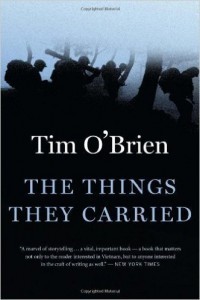 Every writer I knows who has a dedicated working space has furnished it. This piece came out of a challenge prompt from Tim O’Brien’s writing. What do you carry on your daily sojourns?
Every writer I knows who has a dedicated working space has furnished it. This piece came out of a challenge prompt from Tim O’Brien’s writing. What do you carry on your daily sojourns?
My Father’s Grin
Like all people who love their work, I seek to establish an integrity in it, to make what I love to do and what I have to do one and the same. And like all superstitious beings, I need amulets to add magic to what conscious effort and thought can make possible. The largest of these charms is the writing desk I carried home from Oregon, built from red madrona wood. It is the field for the other things that carry me to work:
My father’s grin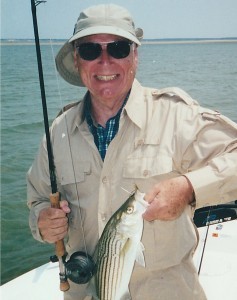
On the back left corner of my desk sits a photo of my father. He stands in a small boat off Cape Cod, holding up a very small fish he’s caught on a fly rod, his first ever. He’s 72 years old and the grin under his sun hat is as goofy and beatific as a boy on his first bike. This photograph reminds me there is no more blessed attitude than that of the amateur, the person who works for love. It tells me to take on things for no other reason than love, the love of something new, the chance to try something you don’t already know how to do. My father’s grin reminds me that while mastery is potent, a wide and seeking love is more so. He reminds me that each task has intrinsic value, and to accept the grace in that.
My mother’s quilt
On the wall in front of my desk hangs a red and white flying-goose pattern quilt my mother sewed for my wife and me. A daughter of the Depression, she still finds it difficult to believe in the abundance of this world, though all her generosities – unspoken and (by her preference) unattributed, bely that part of her history. The quilt and quilter sit with me every day to remind me that, even when I feel I have no more resources, when I feel most poor, I can always afford to give something away through my work. And that will make me better.
My grandfather’s knife
In the right-hand drawer of the madrona desk sits my grandfather’s pocket knife with the black bone handle and deer-horn ends. I forever see him using it to dig out the compacted roots of shrubs he’s transplanting, to cut the fleshy stems of roses for grafts, or to lop a length of string to tie a bunch of newspapers. I use it in the ways he used it, and for sharpening pencils and peeling apples beside, and to remember that, with patience and effort, the most difficult work breaks down into single, simple tasks. Often it’s the simple tools we require, despite what we think, or wish.
Some rocks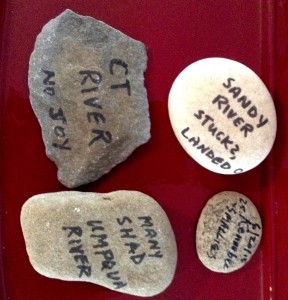
For paperweights, I use the rocks I’ve brought from places I’ve fished, each with a hand-painted legend telling me how I did: “Umpqua River, many shad;” “Deschutes, stuck 2 , landed 1.” Aids to memory, they carry the freight of friends and rivers and time spent in the one church I recognize, the outdoors. My rocks remind me that work and leisure do not conflict but complement, and when I try to bull on through a piece instead of trying to flow with it, I don’t do my best work.
A grandmother’s smirk
One more photograph sits on the desk: my wife’s grandmother celebrating her 93d birthday, her tongue stuck out at the camera. This woman who never dressed in a color but purple and refused the Boston Post Cane when it was offered her (not wanting to be identified as the oldest resident in town) was a devoted Red Sox fan, thus patron of lost causes. (Sadly, she died before 2004). She and her daughter-in-law’s mother listened to games together in their separate houses, the party line open between them for commentary. Her presence in my work place reminds me that too much seriousness is poison, that I need to allow myself to be joyful and loose, however I can manage – I need to take chances with my dignity.
Meditating Mary
Last on the desk sits a white cast resin statue of the Virgin Mary meditating in the lotus position, the original sculpted by my friend Matt Lyon. Matt, the only Buddhist monk I’ve ever drunk Guinness with, died when he laid down his motorcycle in front of a car that ran a Stop sign. Knowing he would likely die, his last impulse was to keep the long line of vehicles behind him from piling up, causing more casualties than his own. Matt’s Mary reminds me to surrender myself once in a while, not hold myself or my work so important it can’t be sacrificed for something larger. And it tells me the intention of a prayer is far more important than the form.
David Mamet said once in an interview: “Being a writer is so ethereal that I think most of us tend to surround ourselves with tchotchkes so we can actually be sure we have a past.”
“Tchotchkes” is too flippant a name for my charms – that might leach their magic – but I understand what he says. The items we travel with choose our various pasts, our presents and futures. And even when I do not see myself whole in my work, I trust my amulets to push me every day. This is what I strive for: a place where my love for the work and my need to do it are united, the place where the things that carry me abide.
March 21, 2016
Popular History: You Can’t Judge a Book by its Publisher
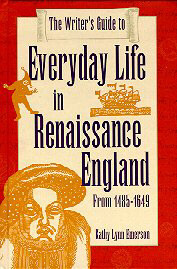 Kaitlyn Dunnett/Kathy Lynn Emerson here, offering a few observations based on having read (or at least skimmed) just about every nonfiction book on Tudor history and most Tudor biographies that have come out in the last 40 years in search of subjects to add to my online “A Who’s Who of Tudor Women” (now over 2000 mini-biographies of women who spent at least part of their lives in England between 1485 and 1603) and as research for my novels.
Kaitlyn Dunnett/Kathy Lynn Emerson here, offering a few observations based on having read (or at least skimmed) just about every nonfiction book on Tudor history and most Tudor biographies that have come out in the last 40 years in search of subjects to add to my online “A Who’s Who of Tudor Women” (now over 2000 mini-biographies of women who spent at least part of their lives in England between 1485 and 1603) and as research for my novels.
Observation One: Well trained scholars (“experts”) can get things wrong. I have read very few scholarly books in which I didn’t spot some error, mostly to do with minor historical persons. The author simply didn’t care enough about these people to check for more recent research and just repeated the accepted “facts.” Worst example? In an otherwise well-researched book on Tudor life, the author claimed, in the chapter on food, that stews were outlawed by Henry VIII. Well, they were, but the “stews” in question were brothels, not the kind you cook in a pot.
Observation Two: Scholars writing for publication almost always have an agenda. To prove a point, they sometimes ignore inconvenient documents and/or theories.
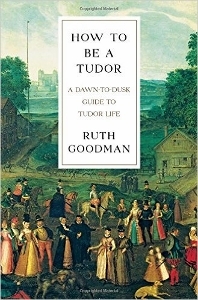 Observation Three: Most historical “facts” are subject to change as new or overlooked documents come to light and old ones are reinterpreted. A recent article by living history expert Ruth Goodman explains why Tudor people, despite avoiding baths, did not, in fact, stink. After reading this article, I ordered her How to Be a Tudor and it turned out to be the best book on everyday life in the sixteenth century I have ever read, and that includes the one I wrote for Writers Digest Books back in 1996.
Observation Three: Most historical “facts” are subject to change as new or overlooked documents come to light and old ones are reinterpreted. A recent article by living history expert Ruth Goodman explains why Tudor people, despite avoiding baths, did not, in fact, stink. After reading this article, I ordered her How to Be a Tudor and it turned out to be the best book on everyday life in the sixteenth century I have ever read, and that includes the one I wrote for Writers Digest Books back in 1996.
Observation Four: When there are two or more interpretations of some historic event, novelists are allowed to pick the one that works best for their stories.
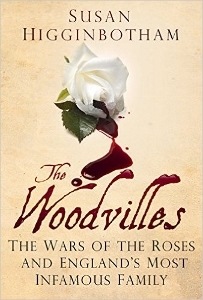 Observation Five: Some of the most interesting material (to me, anyway) comes to light because an independent scholar or an amateur historian interested in one particular aspect of history took the trouble to dig deep and find information overlooked by more scholarly individuals. A recent biography of George Boleyn (George Boleyn: Tudor Poet, Courtier & Diplomat by Claire Cherry and Claire Ridgway) had its origins in a website, “The Anne Boleyn Files.” The Woodvilles was written by historical novelist Susan Higginbotham because no one else had written a history of this fascinating family.
Observation Five: Some of the most interesting material (to me, anyway) comes to light because an independent scholar or an amateur historian interested in one particular aspect of history took the trouble to dig deep and find information overlooked by more scholarly individuals. A recent biography of George Boleyn (George Boleyn: Tudor Poet, Courtier & Diplomat by Claire Cherry and Claire Ridgway) had its origins in a website, “The Anne Boleyn Files.” The Woodvilles was written by historical novelist Susan Higginbotham because no one else had written a history of this fascinating family.
Observation Six: Amateur genealogists also have something to offer. They have a highly personal reason to dig deeper. I found fascinating details on horses in Tudor times in a self-published book from 1990, The Marriage That Did Succeed for Mary Queen of Scots by James Walter Deppa. His ancestors include one of Mary Stewart’s ladies and a young man who worked in the queen’s stables.
Observation Seven: “Popular” histories contain lots of domestic details and, well, gossip, and are what pique most people’s interested in history in the first place. Yes, some of these are cranked out just to take advantage of, say, renewed interest in Henry VIII generated by The Tudors, and some of their authors leap to pretty far-fetched conclusions; but, with luck, they prompt their readers to continue delving into the subject matter. Books by A. L. Rowse, back in the day, fed my interest in the Tudor period. Today, Alison Weir’s biographies do the same thing and her Henry VIII: The King and his Court is a great place for fiction writers to find those telling details that bring a story to life.
Observation Eight: Yes, there are errors in books written by popular historians, and they sometimes draw illogical conclusions, but even the ones that are full of wrong assumptions (every single book I’ve seen that claims to tell you the real story of Henry VIII’s mistresses, for example) contain material of interest, particularly if you are doing research for a novel.
 Observation Nine: When novelists write about real people’s private lives, they owe it to those long-dead individuals to consider all the known facts. Philippa Gregory used Retha Warnicke’s controversial The Rise and Fall of Anne Boleyn as her source for The Other Boleyn Girl. Obviously, this didn’t hurt sales, but in my personal opinion it did a great disservice to at least one minor historical figure. In her book, Warnicke makes several claims that are widely disputed by other scholars who have more logical and fact-based arguments to back them up than she does.
Observation Nine: When novelists write about real people’s private lives, they owe it to those long-dead individuals to consider all the known facts. Philippa Gregory used Retha Warnicke’s controversial The Rise and Fall of Anne Boleyn as her source for The Other Boleyn Girl. Obviously, this didn’t hurt sales, but in my personal opinion it did a great disservice to at least one minor historical figure. In her book, Warnicke makes several claims that are widely disputed by other scholars who have more logical and fact-based arguments to back them up than she does.
Observation Ten: When writing about a real person, if there is a segment of that person’s life during which no one knows where they were or what they were doing, then the novelist is free to extrapolate from the facts and write about what might have happened. Here’s the thing: novels are fiction. In fact, for those really willing to suspend disbelief, there are some excellent alternate history/fantasy novels out there. To name just two, Queen Elizabeth the First fights vampires in The Secret History of Elizabeth Tudor, Vampire Slayer by Lucy Weston, and Anne Boleyn gives King Henry a son who grows to adulthood and inherits the throne in Laura Andersen’s The Boleyn King, the first of a trilogy.
Kathy Lynn Emerson/Kaitlyn Dunnett is the author of over fifty books written under several names. She won the Agatha Award in 2008 for best mystery nonfiction for How to Write Killer Historical Mysteries and was an Agatha Award finalist in 2014 in the best mystery short story category for “The Blessing Witch.” Currently she writes the contemporary Liss MacCrimmon Mysteries (The Scottie Barked at Midnight) as Kaitlyn and the historical Mistress Jaffrey Mysteries (Murder in the Merchant’s Hall) as Kathy. The latter series is a spin-off from her earlier “Face Down” series and is set in Elizabethan England. Her websites are www.KaitlynDunnett.com and www.KathyLynnEmerson.com And, if you are interested in reading about the real women who lived in England in Tudor Times, click here to go to the index for “A Who’s Who of Tudor Women”
March 20, 2016
Iterative Versus Linear Processes in Publishing
By Barb, who has made it back to New England in time for our very last snow, apparently
Last week, as I read Jane Friedman’s excellent blog post on the takeaways for authors from Digital Book World, I was struck once again by the idea that traditional publishers are stuck in a world of linear manufacturing processes when, in fact, it is their iterative processes they need to embrace to survive.
Development versus Manufacturing
In my previous life I worked as a Chief Operating Officer for an educational technology company that developed and distributed software that institutions of higher education used to put courses, or even more often, to put some course functions (self-quizzing, grading, submission of papers, etc.) online. At this company, we partnered with the big textbook publishers and in those days (1996-2006), despite the fact that one of those publishers had a large investment stake in our company and a seat on the board, the relationships were fraught.
After struggling for years with hysteria on one side or the other, I realized that one of the major problems between a software company like ours and the textbook publishers was that our processes were almost all iterative, whereas theirs were linear.
In the software world, particularly when you are creating a new category of product, you normally put out a version that has your best guess as to what your target users want and need. You see if customers or users rally to it (i.e. if it’s even worth investing more time and money in). If users do like it, believe me, they’ll tell you in no uncertain terms what other features they need and where the bugs are. The work of fixing the current version and creating new versions is constant, all part of a conversation with customers and users. Cycles have shrunk and gone faster even since I stepped out of the field in 2010.
At the publishers, the editors worked under a very different burden. Each edition of the book was an endpoint and it had to be absolutely perfect. At least that was the goal. This was the product that their salespeople would carry around in the trunks of their cars for the next three years. No changes.
Our very different mindsets about how we were working and the goals of our processes caused a huge amount of our conflict. (Earlier this month, McGraw-Hill announced that sales 2015 unit sales of digital platforms and programs exceeded those of print in its U.S. Higher Education Group for the first time. I imagine the culture has changed there, too.)
What does that have to do with fiction?
Producing quality fiction books requires both iterative and linear processes.
When we think of the great era of book editors, we think of a conversation between a writer and editor that shaped a book and made it great. Iterative processes are inherently creative processes.
But often publishers think like manufacturers. Ask anyone who’s ever tried to get an error in a book changed, even in the digital version. Or tried make a significant change at the galley stage. Galleys are treated as if they are typeset in printer’s trays the way my great-grandfather used to do it. “I don’t know how you do it,” a friend of mine told her editor, “but I’m using a computer.”
I realize that every time they open a file on a computer, it costs a publisher money. But the linear mindset causes publishers not to do things that are easy and cheap. Like fixing a book’s metadata after it’s released. Or adding a buy link for the next book in a series into a published ebook. What better, cheaper, more targeted form of advertising? Or dropping the price of the e-book for a time period. Some publishers act as if the price is still printed on the cover. As Friedman points out in her report, they can always raise it again.
But doing things like that involves changing your mindset to realize that producing the book is no longer an endpoint and paying attention to the book long after the traditional short promotional period that follows a book’s release. Many traditional publishers haven’t shown themselves to be great at that.
No, I don’t want novels to become like software with changes constantly made based on readers’ suggestions. There are other methods of storytelling that support that approach better, including interactive gaming and forms of experimental fiction. The novel’s strength is that it is one person’s vision and it is inevitably shaped by the time in which it is written. (One of my favorite series is Jasper Fforde’s Thursday Next books in which the canon must constantly be repaired from damage caused by wandering literary tourists.)
But I do think it’s the iterative processes at publishing houses that are the valuable ones—curating their list, and making those books the best they can be. Technology will make the manufacturing part of producing books ever faster and more cost-efficient. We’ve already reached the point where printing access and costs are not barriers to entry for anyone. Can they big publishers change their mindsets? It will be interesting to watch.
Usual caveats:
I actually have a great relationship with my publisher. As a medium-sized house they’ve shown themselves willing to experiment with pricing and marketing in many ways, including changing ebook pricing long after a book’s release.
Authors are not really insiders when it comes to publishing. We’re not at the table when the important decisions get made. So you should view these opinions only as those of a highly interested observer.
March 18, 2016
Weekend Update: March 19-20, 2016
 Next week at Maine Crime Writers there will be posts by Barb Ross (Monday), Kaitlyn Dunnett/Kathy Lynn Emerson (Tuesday), Dick Cass (Wednesday), Maureen Milliken (Thursday), and Kate Flora (Friday).
Next week at Maine Crime Writers there will be posts by Barb Ross (Monday), Kaitlyn Dunnett/Kathy Lynn Emerson (Tuesday), Dick Cass (Wednesday), Maureen Milliken (Thursday), and Kate Flora (Friday).
In the news department, here’s what’s happening with some of us who blog regularly at Maine Crime Writers:
Barb: Hi. There’s another great review of Best New England Crime Stories: Red Dawn up on George Smith’s Maine blog, with shout-outs to several Maine Crime Writers, including Kate Flora, Dorothy Cannell and Bruce Coffin. http://www.georgesmithmaine.com/articles/book-reviews/march/2016/red-dawn-delivers-great-new-england-crime-stories.
Meanwhile, after a long winter, who will I get to see at the Maine Crime Wave?
Kathy: Speaking of Maine Crime Wave. There is also “Two Minutes in the Slammer” the night before. Want to see how people react to a short reading from your work-in-progress? Here’s your chance. There are still slots open on the schedule. I did this last year and not only was it great fun, it gave me the opportunity to get a glimpse of what other folks were writing. At least two of those talented people have signed book contracts since then.
+ MAINE CRIME WAVE http://mainewriters.org/2016-maine-crime-wave/
+ SCHEDULE http://mainewriters.dreamhosters.com/?page_id=3223
+ PANELISTS & WORKSHOP LEADERS http://mainewriters.org/panelists-workshop-leaders/
+ REGISTRATION DUE April 5, 2016
+ TWO MINUTES IN THE SLAMMER Open Mic Reading Friday, April 8

An invitation to readers of this blog: Do you have news relating to Maine, Crime, or Writing? We’d love to hear from you. Just comment below to share.
And a reminder: If your library, school, or organization is looking for a speaker, we are often available to talk about the writing process, research, where we get our ideas, and other mysteries of the business. Contact Kate Flora: mailto: kateflora@gmail.com
March 17, 2016
Ten Things You Don’t Know About My Writing Journey
Lea Wait, here, suspecting you’re reading this because you know me, or you know my books, or you love mysteries, or write them, or you have nothing scheduled for the next few minutes. 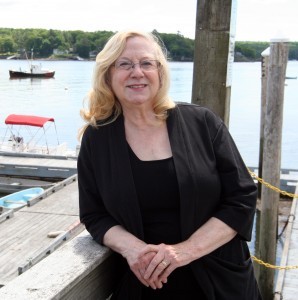
So, I thought today I’d share a little bit about how I got to where I am. I’ll focus on my writing, not on all of my life. (My life would take at least two blogs.)
I decided to be a writer when I was in second grade. I kept escaping my classroom to the library (never one to set low goals, I’d decided to read every book in the library) and my teacher had a serious talk with me. “When you grow up you can be a writer, and spend all your time in the library. But first you have to finish second grade.” From that point on I told everyone I was going to be a writer.
A little later on I was editor of my high school newspaper, which won an award from the New Jersey Press Association for being the best high school newspaper in New Jersey that year.
I spent one summer in high school working at The Boothbay Register, a weekly paper in Maine that’s still around. My job was to proofread, walk around town to pick up ads, and remind local columnists if their columns were late. One of the men I worked with pinched. (Welcome to the adult world!)
I majored in English and drama in college, since I couldn’t decide which one I liked better. I wrote plays for children’s theatre and poetry. Several of the plays were produced on campus, and one of my poems won a national award. Marianne Moore was the judge of the poetry contest; she praised my work, and I was thrilled. (The poem is on my website (see “Ellie Poem” under “Books”) and is used in high school and college classes in several countries today.)
My first post-college job was as an executive speech writer at a now-defunct company called Western Electric, which manufactured telephones and other equipment for the old Bell System. When I was given my first assignment on the executive floor, the secretaries there wouldn’t let me in. They didn’t believe a woman could be a speechwriter.
Later I worked for AT&T and for two years was the producer, writer, and on-camera talent for a daily CCTV show for employees in New York City and New Jersey.
My master’s thesis (New York University) was on the changing role of the mother in fiction for teenagers written from 1950–1955 and 1960-1965. (As I remember, most of the 100 books I read focused on team sports or getting a date for the prom.)
My daughters, Xmas, 1987
For about ten years, as the single adoptive parent of four and advocate for older child and single parent adoption, I wrote a bimonthly adoption newsletter for adoptive parents and prospective parents, and contributed articles on adoption to anthologies.
My first published fiction was a short story from the point of view of a fourteen-year-old girl giving birth to a child with Down Syndrome. It was published in a literary magazine called Happy.
And the first full book I wrote, a mystery, was rejected by over forty agents. Eventually, about six years later, it was published by Scribner as Shadows at the Fair, and was a finalist for a “best first” Agatha. It wasn’t the first book I’d had published, though. That was a book for ages 8-12 set in 1806 Maine called Stopping to Home.
I’ve had sixteen books published since Stopping to Home in 2001, and two more, one in each of my mystery series, will be published next fall: Shadows on a Morning in Maine in September, and Dangling By a Thread in November.
And I’m still writing. The journey continues ….. thank you for coming along!
March 16, 2016
Do You Suffer From Postnovel Depression?
Vaughn C. Hardacker here: I just finished the rewrite of a novel and sent it off to my editor. Now I find myself deep in the doldrums of what I call Postnovel Depression. The closest thing I can equate it to is the postpartum depression some mothers experience 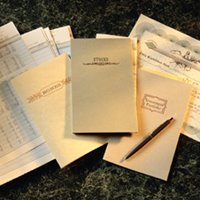 after birth of a child. I mope around and check email thirty or forty times a day looking for those cherished words from my editor: “Can I send you a contract?”
after birth of a child. I mope around and check email thirty or forty times a day looking for those cherished words from my editor: “Can I send you a contract?”
I close email and open scrivener to work on a new novel and after several moments, close scrivener and check email. I tell my self to relax and stop being ridiculous…it takes time for an editor to work through the slush pile to get to my manuscript and more time for him to read it. I hate that word: TIME! I mutter, moan, and curse. I complain that if all industries moved at the pace of the publishing industry, the Industrial Revolution would only still be a future event.
I tell myself not to get too upset, what is; is and all writers go through the same thing (Have I mentioned that I suffer from grandiosity? Of course I’m the only writer who goes through this!). So I check email again…
This goes on for a week or more until I start believing that I’ll never again complete a novel. I open scrivener to work on a new novel and after several moments, close scrivener and check email. (Is this starting to sound like the script of Groundhog Day?) I mutter, moan, and curse…
Finally, usually late at night, I have an epiphany and open scrivener–this time I start developing character sheets for my antagonist (in a series there isn’t much to do with protagonists, especially after the first couple of books) and the various settings in which the story will take place. Voila! I start chapter one and I’m off and running.
I completely ignore the fact that at the end of the book Postnovel Depression is waiting for me, after all aren’t our books and the characters in them our children? Of course, you probably have no idea of what I’m speaking. This only happens to me! (Have I mentioned that I suffer fr om grandiosity?)
om grandiosity?)
By the time this post goes live, THE BLACK ORCHID, will have been released and I will be at a book launch party at the Jesup Memorial Library, 34 Mt Desert St, Bar Harbor, ME 04609. If you’re in the neighborhood, stop by.
Vaughn C. Hardacker is the author of three thrillers: SNIPER (finalist for 2015 Maine Literary Award in Crime Fiction category), THE FISHERMAN, and THE BLACK ORCHID (released March 2016). He lives in Stockholm, ME which he describes as being “five minute south of the end of civilization as we know it.” He does however, visit the United States several times each year.
March 15, 2016
Keepers of the Flock: Reflections on Feeding Wild Birds
Jen Blood here, on a rainy evening of reflection after a rainy day of much of the same here in Maine. These days I live in Cushing, a little fishing village in the mid-coast, where I’ve rented a house with my mom for the past three years. While there are, inevitably, challenges to living with a parent when one is an adult, she’s quite a kick to hang out with, and there’s been something kind of wonderful about reconnecting these past few years. I’m 42 now, which means I’m becoming increasingly aware of that inevitable, onward march of time. I’ll be moving on to new digs come spring, so in anticipation of that, I’ve been getting a little sentimental about the things I’ll miss about this latest home of mine.
One of my favorite parts of this place is the deck just outside our back door, which looks out on an expansive lawn and a pond perfect for ducks, geese, trout, and turtles. My mom is a big fan of birds, so last year I went a little nuts and bought feeders and a bird bath, bird houses and birdseed, suet and flowers and bright red hummingbird feeders. The birds, naturally, were psyched about the arrangement. Over the course of the summer, we watched two batches of robins nest, an exhausted papa robin feeding the babies until they were plump little fuzzballs just testing their wings.
We watched house finches nest on the other side of the porch, their antics once the babies were grown riotous to watch. There were hummingbirds and woodpeckers, cardinals, goldfinches, chickadees and nuthatches and red-winged blackbirds and tufted titmice (if you, like me, are not convinced titmice is the correct word, see this great post at Bird Watcher’s General Store). There were, in other words, a lot of birds.
Because I love animals and try to be a good steward of the planet, feeding this many birds naturally led to the question: Should I actually be feeding wild birds? I’ve been taught since I was little not to feed the bears at the zoo or the raccoons in my yard, regardless of how cuddly they might look. Which, let me tell you, was not a popular position when I was seven. That’s not just for my well-being, however; it’s for theirs. 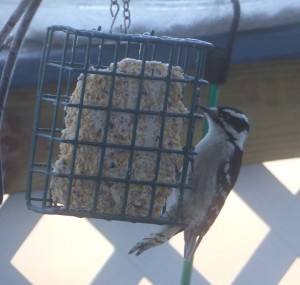 But, try as I might, I haven’t found anything definitive telling me that feeding the birds is a bad thing. There’s no question that it’s quite the industry: “Households in the United States and the United Kingdom put out over 1 billion pounds of food, including seeds, bread and even peanuts, for backyard birds each year,” according to this article at www.livescience.com. The same article cites a 2008 study done by a team of researchers from the University of Exeter and Queen’s University Belfast, which came to the conclusion that, “The birds given more to snack on in the winter months laid eggs earlier than the birds in the other group, and they had an average of one more nestling that flew away from the nest successfully.” In other words… Feeding wild birds is not only okay, it’s good for them. At least, it is according to that single study — I’m sure there are dissenters.
But, try as I might, I haven’t found anything definitive telling me that feeding the birds is a bad thing. There’s no question that it’s quite the industry: “Households in the United States and the United Kingdom put out over 1 billion pounds of food, including seeds, bread and even peanuts, for backyard birds each year,” according to this article at www.livescience.com. The same article cites a 2008 study done by a team of researchers from the University of Exeter and Queen’s University Belfast, which came to the conclusion that, “The birds given more to snack on in the winter months laid eggs earlier than the birds in the other group, and they had an average of one more nestling that flew away from the nest successfully.” In other words… Feeding wild birds is not only okay, it’s good for them. At least, it is according to that single study — I’m sure there are dissenters.
There is some disagreement as to whether it’s wise to continue feeding wild birds during the spring and summer months, but the Cornell Lab of Ornithology takes the position that it’s fine as long as you keep things clean.
 Between my mom and I, we’ve managed to do that, and these days find ourselves keepers of a diverse flock. In the mornings when I’m here, I have a set routine in which I take my pup Killian out for a walk around the back forty, come in and make breakfast, and then — before sitting down to eat — go outside to feed the birds. Right now, that means black oil sunflower seeds, wild bird food, and roasted, unsalted peanuts still in the shell. After doing this for months, I’ve become accustomed to the routine once the food is out and I’m back inside, though I still get a kick once I see the first chickadee wend its way to the railing. That sole chickadee seems to provide a signal to the others.
Between my mom and I, we’ve managed to do that, and these days find ourselves keepers of a diverse flock. In the mornings when I’m here, I have a set routine in which I take my pup Killian out for a walk around the back forty, come in and make breakfast, and then — before sitting down to eat — go outside to feed the birds. Right now, that means black oil sunflower seeds, wild bird food, and roasted, unsalted peanuts still in the shell. After doing this for months, I’ve become accustomed to the routine once the food is out and I’m back inside, though I still get a kick once I see the first chickadee wend its way to the railing. That sole chickadee seems to provide a signal to the others.
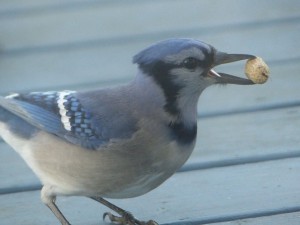 The blue jays — who are huge fans of the peanuts — swoop in next, cramming one peanut down their gullet before grabbing another to fit in its beak. Woodpeckers head for the suet. Cardinals, titmice, finches, and nuthatches sweep in when there’s an opening, but everyone takes off when the mourning doves head in. The mourning doves and red-winged blackbirds have become something of an issue, so we’ve set things up now so that the feeders — which discourage larger birds — are on one end of the deck, suet hangs from the trees, and a couple of open feeders on the other end of the deck hold black-oil sunflower seeds for the big guys. It’s kind of a zoo, to be honest.
The blue jays — who are huge fans of the peanuts — swoop in next, cramming one peanut down their gullet before grabbing another to fit in its beak. Woodpeckers head for the suet. Cardinals, titmice, finches, and nuthatches sweep in when there’s an opening, but everyone takes off when the mourning doves head in. The mourning doves and red-winged blackbirds have become something of an issue, so we’ve set things up now so that the feeders — which discourage larger birds — are on one end of the deck, suet hangs from the trees, and a couple of open feeders on the other end of the deck hold black-oil sunflower seeds for the big guys. It’s kind of a zoo, to be honest.
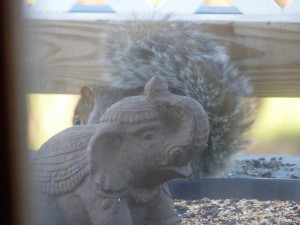 But, it is — however temporarily — my zoo, and the mornings that I’ve spent watching the birds and the squirrels and the chipmunks lobby for position at the feeders, talking to my mom about life, death, taxes, and the latest episode of The Voice, are mornings that I expect will become treasured memories in the years to come. So, here’s to the winged creatures of the world, and the quiet moments of peace and reflection they bring us.
But, it is — however temporarily — my zoo, and the mornings that I’ve spent watching the birds and the squirrels and the chipmunks lobby for position at the feeders, talking to my mom about life, death, taxes, and the latest episode of The Voice, are mornings that I expect will become treasured memories in the years to come. So, here’s to the winged creatures of the world, and the quiet moments of peace and reflection they bring us.
What about you? Do you have bird feeders at your place, or are you of the mind that wild things are better left to their own devices?

